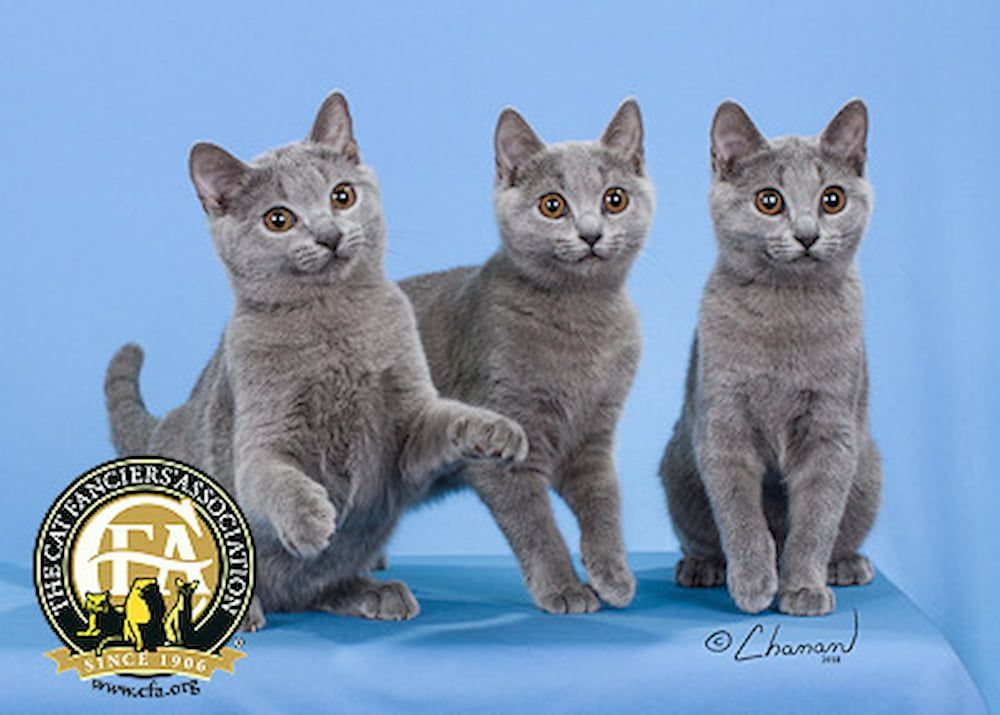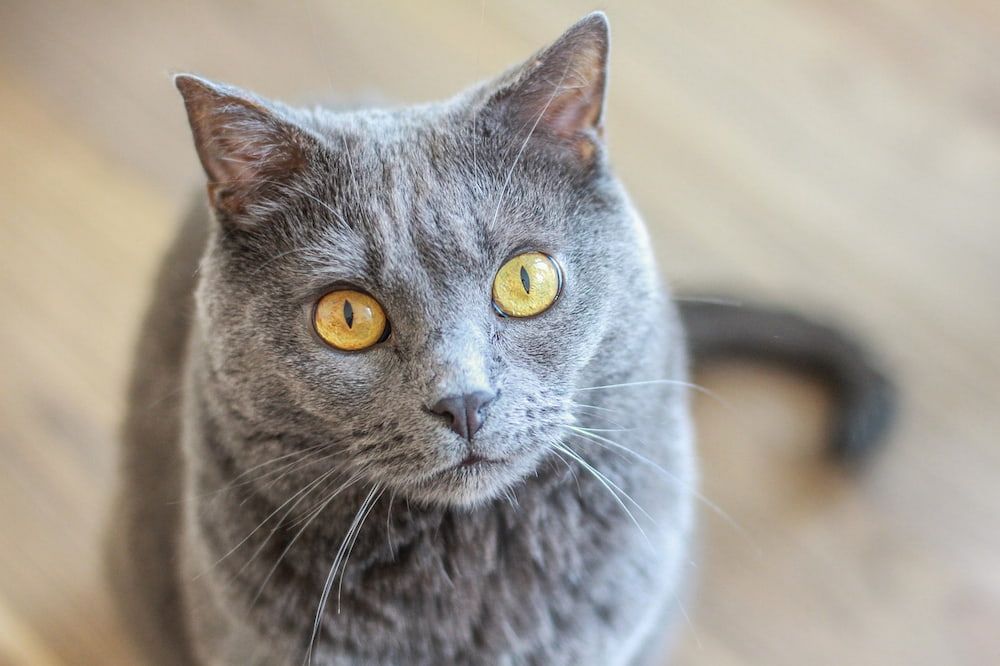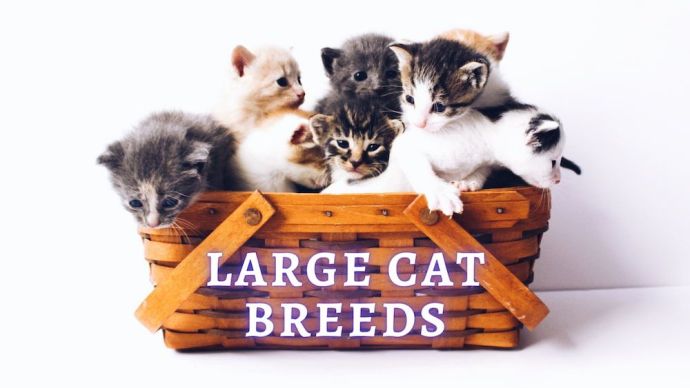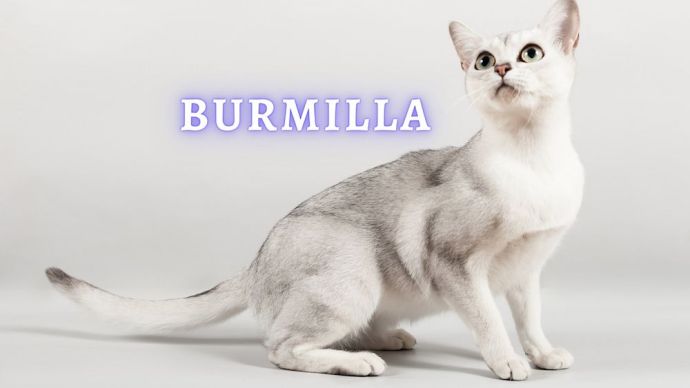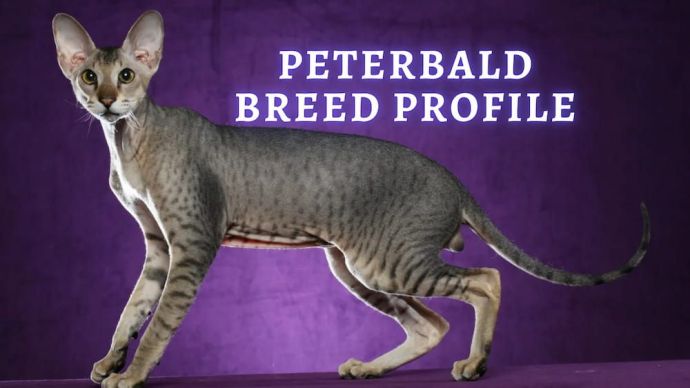Chartreux Cat Breed Personality, Care and Lifespan
Written by:
Author: Scott Jeffrey
Scott is a professional blogger with 12+ years of experience in writing, and holds an MA in anthropology. He has two cats as housemates. Also, Scott is passionate to research on pet-related topics such as dog training, puppy feeding, and cat health.
View all 63 articlesLearn about our editorial process and veterinary review board.
Viewed: 43
Updated on: 05/26/2023
The Chartreux is a captivating feline hailing from France, has captured the hearts of many with its charming personality and striking appearance. Often considered the unofficial mascot of the country, the Chartreux has gained popularity not only in its homeland but also among cat enthusiasts worldwide. This breed is truly a sight to behold, distinguished by its luxurious blue-gray, coat color, unique woolly texture, and mesmerizing copper eyes.
Despite its seemingly delicate appearance, the Chartreux cat boasts a muscular and athletic build, which may be surprising given its tiny, fine-boned legs. This compact stature can give the impression of a shorter cat, but don’t be fooled – the Chartreux is a formidable hunter. Legends suggest that the Carthusian monks of France once enlisted these skilled felines to keep their monasteries free of rodents.
Not only is the Chartreux cat an efficient mouser, but it’s also renowned for its amiable disposition. These gentle and affectionate cats are known to form strong bonds with their humans, making them ideal companions for families and individuals alike. As you get to know the Chartreux, you’ll discover this enchanting French feline is much more than a pretty face.
Characteristics and Appearance:
As we delve further into the captivating world of the Chartreux cat, it’s essential to understand the unique physical characteristics that set this breed apart from others. Below, you’ll find a detailed chart highlighting the key features of these charming felines, providing a comprehensive visual guide to their distinct appearance. This will allow you to appreciate their enchanting beauty and learn the unique qualities you should seek from a Chartreux breeder.
| Weight | 15-16 lbs |
| Length | 20-24 inches |
| Colors | Solid Gray |
| Eye Color | Orange or copper |
| Lifespan | 15 years |
| Hypoallergenic | No |
| Coat Length | Short |
| Breed Origin | France |
Breed History
The enigmatic Chartreux cat has a history that is as fascinating as it is elusive. While the precise origins of this enchanting breed are challenging to pinpoint, it is widely accepted that the Chartreux dates back at least to the 15th or 16th century. The distinctive woolly coat of these captivating felines suggests Syrian roots, and it is widely believed that Crusaders brought the early ancestors of the Chartreux back to France upon returning from their expeditions.
Once in France, the Chartreux quickly gained a reputation for being highly effective rodent hunters. Numerous accounts suggest that French Carthusian monasteries employed these skilled felines to protect their sacred spaces from rats and mice. Although no concrete evidence has been found in Carthusian records, this enduring tale may also explain these remarkably silent cats’ quiet, almost meditative nature.
As we progress in history, the journey of the Chartreux becomes clearer. In the 1920s, sisters Christine and Suzanne Leger discovered a colony of striking blue-gray cats on a small island off the French coast. They were captivated by the cats’ unique woolly coats and decided to domesticate and breed them. By 1931, the modern Chartreux debuted at a Parisian cat show, capturing the hearts of many.
World War II posed a significant threat to the survival of the Chartreux breed. Still, these extraordinary felines managed to endure through selective crossbreeding with Russian Blue, British Shorthair, and Persian cats. Over time, the Chartreux became increasingly sought after for its luxurious, thick coat,, intelligence, and gentle temperament.
The first Chartreux cats arrived in the United States in 1970, thanks to John and Helen Gamon. This marked the beginning of the breed’s journey towards full acceptance into the Cat Fancier’s Association in 1987. Today, the Chartreux is considered a national treasure in France, with its popularity remaining relatively contained within Europe. Due to many breeding programs returning their stock to France, finding a purebred Chartreux kitten outside of Europe has become increasingly difficult.
Interesting facts about the breed
With its rarity and mystique, the Chartreux cat offers a treasure trove of fascinating facts for feline enthusiasts to uncover. Here are a few intriguing tidbits about this exceptional breed:
The French have devised a unique naming system for pedigree cats, including the Chartreux. Each year, all registered kittens are given names that begin with the same letter, cycling through the alphabet annually with only a few letters omitted. This method ensures that the birth year of each cat can be easily determined just by looking at its name.
Some famous historical figures have been proud Chartreux owners, such as the celebrated French novelist Colette and the renowned poet Charles Baudelaire. Their love for this captivating breed further demonstrates the timeless appeal of the Chartreux. These are cat breeds that rose to a huge popularity throughout World War II and as French breed cats started to make their way to North America after the war. The medium-sized cat became a wanted item as the Chartreux breed rose to become beloved pets as family cats.
The Chartreux holds a special place in the music world as the mascot for the Montreal International Jazz Festival, the most prominent jazz festival globally. Named “Ste Cat” in honor of the event’s central hub on Sainte Catherine Street in downtown Montreal, this feline mascot symbolizes the festival’s relaxed and sophisticated vibe.
Known for their intelligence and playful nature, many Chartreux cats can learn to play fetch, providing endless entertainment for their human companions.
The Chartreux’s first mention in literature by the French naturalist Buffon saw it assigned the Latin name Felis catus coeruleus, which translates to “blue cat.” This reference meaning blue cat highlights the breed’s distinctive blue-gray coat that has captivated admirers for centuries.
RELATED: Gray Cat Breeds
Personality
As we continue exploring the captivating world of the Chartreux, it’s essential to understand the unique personality traits that make this breed endearing. Below, you’ll find a comprehensive chart that outlines the critical aspects of the Chartreux’s temperament, offering valuable insights into what makes these felines such delightful companions. This information will deepen your appreciation for the breed and help you determine if the Chartreux matches you and your household.
| Friendly | Very |
| Good with Other Pets | Very |
| Need for Exercise | Moderate |
| Playful | Moderate |
| Intelligence | High |
| Vocal | Low |
| Shedding | Moderate |
| Affection | Very |
Activity
Chartreux cats are known for their moderate activity levels, requiring regular mental and physical stimulation to keep them happy and healthy. As a Chartreux owner, you must be tuned to your feline companion’s habits and temperament, as these soft-spoken kitties may not vocalize their needs or concerns. By closely observing any changes in indoor cats’ behavior, such as decreased water intake or increased sleep, you can address potential issues promptly with the help of a veterinarian.
Although Chartreux cats may appear reserved, they are far from shy. Their calm and undemanding nature allows them to adapt well to being left alone at home without resorting to destructive behaviors or loud protests. This makes them an excellent choice for apartment dwellers concerned about disturbing neighbors with noisy pets. The Chartreux’s quiet demeanor extends to their communication style, as they often express their needs through gestures rather than vocalizations.
The easygoing and tolerant personality of the Chartreux makes them a fantastic fit for families with children and other pets. Thanks to their adaptability, they also prove to be great travel companions. However, providing routine and stability for your Chartreux is essential, as these laid-back felines appreciate knowing what to expect in their daily lives. You can ensure that your Chartreux cat remains content and thriving by offering a balanced mix of mental and physical stimulation and a stable environment.
Care
Caring for a Chartreux is relatively straightforward, making them an excellent choice for first-time cat owners. These charming felines have simple needs: a well-balanced, nutritious diet with, daily exercise, mental stimulation, and quality time with their human companions.
To maintain your Chartreux’s weight, it’s essential to measure their meals and be mindful of treat consumption. Consult your veterinarian if you have concerns about your cat’s weight or dietary requirements.
Providing ample play and exercise opportunities will help regulate your Chartreux’s weight and allow them to burn off any excess energy. As intelligent cats, they thrive on mental stimulation. Investing in puzzle games or teaching them tricks and commands can be a rewarding experience for you and your feline friend.
It’s crucial to remember that cats are known for hiding their discomfort when they’re unwell. It is often hard to detect health problems until they are pretty severe; even Chartreux kittens can be great at hiding health problems. Since Chartreux are naturally calm and reserved, detecting any signs of illness may be challenging compared to many cats you have had before. To ensure your cat’s optimal health, schedule yearly check-ups with your veterinarian and keep up with their flea, tick, and heartworm medications.
RELATED: Is My Cat In Pain?
While this French cat breed is generally very healthy, they can still be susceptible to specific issues. Based on claims data, the top five conditions affecting these cats include urinary tract infections (UTIs), digestive problems, behavioral disorders, ataxia (loss of coordination), and sensitive skin.
As a responsible cat owner, you can be an expert on some of these conditions. However, having a basic understanding of preventive measures and key symptoms can be beneficial in ensuring your Chartreux cat stays happy and healthy throughout its life.
VET GUIDE: Cat Skin Problems
Adoption
Embarking on the journey to adopt a Chartreux cat can be challenging due to the limited number of breeders in the United States. To begin your search, consider exploring resources such as the Cat Fanciers’ Association (CFA) Breeder Directory and The International Cat Association (TICA) Breeder Directory. This will be the best way to find Chartreaux kittens from a reputable breeder from the national cat breed associations.
Although finding a Chartreux in a shelter is uncommon, circumstances may sometimes lead to these purebred cats being surrendered by their owners. Look for potential adoption opportunities at local shelters or rescue organizations, and you might find the perfect Chartreux companion to welcome into your home. Cat breeders may know where to find these breeds at local rescue programs.
Breed Overview
In conclusion, with its calm and serene demeanor, the Chartreux cat breed has captured the hearts of both solitary owners and families alike. Their adaptable nature makes them an excellent fit for various lifestyles, including those who enjoy traveling with their feline companions. It is essential to ensure that children and other pets are taught to interact with the animal gently and respectfully. Ultimately, this enchanting breed offers a unique blend of intelligence, charm, and tranquility, making them a delightful addition to any household.
People Also Ask:
Are Chartreux cats aggressive?
Chartreux cats are generally not aggressive but are known for their calm and gentle nature. These affectionate felines form strong bonds with their human companions and are typically good with children and other pets. However, as with any cat breed, individual cat personalities may vary, and it’s always important to monitor interactions and ensure a harmonious environment for your Chartreux cat.
What is the price of a Chartreux cat?
The price of Chartreux cats can vary depending on factors such as the breeder’s reputation, location, and the kitten’s pedigree. On average, a Chartreux kitten from a reputable breeder may cost anywhere between $800 to $1,500. It’s essential to remember that additional costs, such as vaccinations, spaying/neutering, and other health-related expenses, should also be considered when adopting a new feline companion.
Can Chartreux cats be left alone?
Chartreux cats are known for their independent and undemanding nature, which allows them to tolerate being left alone for reasonable periods. However, prolonged isolation can lead to boredom and potential behavioral issues. It’s essential to provide your Chartreux with engaging toys, mental stimulation, and social interaction to ensure their well-being and happiness when you’re away from home.
Is Chartreux cat a lap cat?
Chartreux cats are known for their affectionate and loving nature, and many enjoy spending time on their owner’s lap. However, individual personalities may vary, and some Chartreux cats might prefer sitting nearby rather than directly on your lap. Regardless, these charming felines are generally fond of being close to their human companions and sharing quality time.
 Cat Breeds Cats That Look Like Leopards: 10 Cat Breeds That Look Exactly Like Leopards
Cat Breeds Cats That Look Like Leopards: 10 Cat Breeds That Look Exactly Like Leopards - 277
- 0
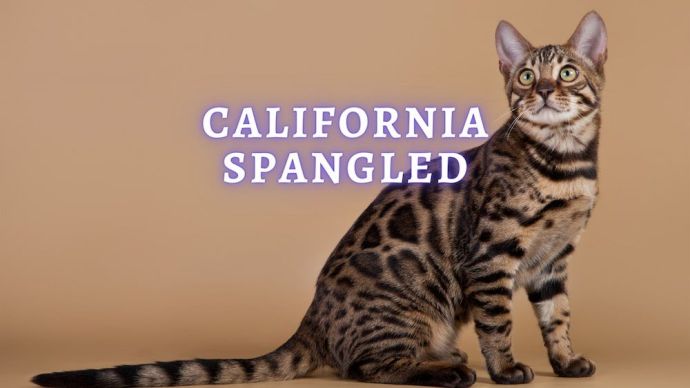 Cat Breeds California Spangled: California Spangled Cat Personality, Breed History, and Interesting Facts
Cat Breeds California Spangled: California Spangled Cat Personality, Breed History, and Interesting Facts - 244
- 0
 Cat Care Why Does My Cat Attack My Legs? 10 Reasons Why and What To Do About It (Vet-Approved Advice)
Cat Care Why Does My Cat Attack My Legs? 10 Reasons Why and What To Do About It (Vet-Approved Advice) - 45103
- 21
 Cat Veterinary Tips Cat Stomach Gurgling: Vet Advice on Why is Your Cat Stomach Gurgling?
Cat Veterinary Tips Cat Stomach Gurgling: Vet Advice on Why is Your Cat Stomach Gurgling? - 33755
- 4
 Cat Veterinary Tips My Cat Lost its Voice: Can Cats get Laryngitis? (Vet Advice)
Cat Veterinary Tips My Cat Lost its Voice: Can Cats get Laryngitis? (Vet Advice) - 22895
- 13











